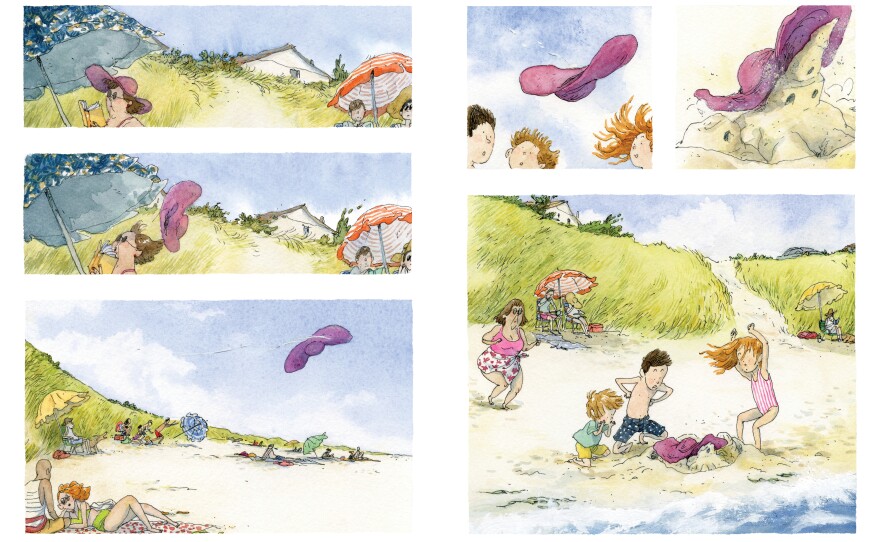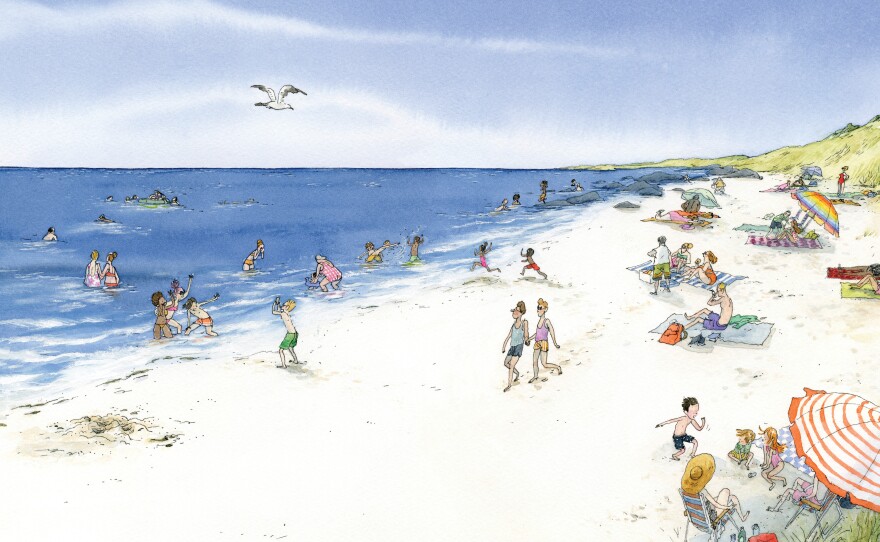About 10 years ago, JonArno Lawson was at a beach in Virginia watching his kids build sandcastles right next to the waves.
"I kept trying to get them to come back because I thought it was a terrible idea," he says. He wanted them to build their sandcastles closer to the dunes. But they found it more exciting to build right where the waves hit, seeing their sandcastles get destroyed, and then re-building them with whatever debris washed up from the ocean.
"It seemed so symbolic, somehow, of... how life works more than just building your perfect sandcastle," says Lawson.
When he decided to turn that sunny day into a children's book, the idea came to just use pictures. "It seemed like it would work beautifully without words," he says. "Like the whole thing would just be visual."
A Day For Sandcastles is illustrated by Qin Leng. It's the second wordless picture book for Lawson and Leng since 2021's Over The Shop.
For the new book, Lawson gave Leng a short manuscript — basically a one-page movie script — of what he was picturing. "It's a real collaboration that way because how it then appears is completely Qin," says Lawson.
Leng illustration's stay pretty true to real life. A trio of siblings — who Lawson says even look like his kids, though he didn't share photos with Leng — spend the day building sandcastles and watching them get destroyed by a flying hat, an errant toddler and the surf.
"To me, it's a celebration of childhood and the simple joys of life," says Leng. "This is the sort of thing I like to capture. I like to draw people. I like to draw them in the day-to-day mundane moments, but moments that all of us can relate to."
Leng spent part of her childhood in France, and says she is inspired by European comic books. For A Day For Sandcastles, she used a fountain pen with the smallest nib she could find to make very detailed, very refined illustrations with a very light watercolor wash. She also added in a lot of personal touches.
"What I love to do when I illustrate picture book is to add side stories to the main storyline," Leng explains. "I always think about the reader and the longevity of the book, and I want them to be able to discover something new every time they revisit the book."
She hid characters that readers might recognize from Over The Shop into the beach scenes. She was also inspired by a trip that her own family took to Cape Cod during the year she was illustrating A Day For Sandcastles and included her own family chasing after a runaway beach umbrella in the background of one of the panels.

JonArno Lawson and Qin Leng agree that one of the best parts about wordless picture books is the experience of sharing them with kids.
"I've noticed my son is more engrossed in observing the small details on the panels rather than just listening to me read the sentence and moving on to the next page," Leng says. "As the reader, you have to piece it together and sort of solve the riddle, you know, figure out what is happening on the page."
Lawson says one of the things he didn't expect was how much kids would want to interact with a wordless picture book. "They have their own memories that they'll connect," he says. "And they'll have, you know, fierce disagreements in classrooms. But it's good. It's sort of like a conversation."
As the day goes on, the siblings take a lunch break on the beach before building yet another sandcastle. They keep getting bigger, more elaborate.
Leng says one of the challenges in illustrating A Day For Sandcastles is that she only had one location to work with; she had to make each page look a little different, so it wasn't all blue sky, yellow sand, blue water.

"Nothing really changes. So it was about how to make the compositions interesting," she says. To do that, she drew the scene from different angles, and broke the beach up into panels — almost like a graphic novel. There's wide shots and close-ups, and she played a lot with the lighting. The day starts at dawn, with a cool light, and by lunchtime you can practically feel the sun getting hotter and hotter, before turning yellow closer to sunset.
"There's a softness at the end of the book, I think, where it feels like the book is falling asleep when we're done with it," says Leng.
At the end of the day, the sleepy-eyed kids pile into the bus that will take them home. Lawson says those last pages are some of his favorite. "It captures that feeling like at the end of the day at the beach, when it's getting dark and you feel completely baked," he says. It must be a universal childhood feeling: crusty with sand, sticky from the salt, hot from the sun, ready to fall asleep the moment you get in the car.
"It's a bit of melancholy at the end of the book, I think when the day is over and they have to go away," says Leng.
That's the funny thing about memories, says Lawson. "If you've had a sad experience you remember it sadly. But if you had a happy experience it's also kind of sad."
"That's vacation," adds Leng, laughing. "That's summer vacation."

Samantha Balaban and Melissa Gray produced and edited this interview for broadcast.
Copyright 2022 NPR. To see more, visit https://www.npr.org. 9(MDAzMjM2NDYzMDEyMzc1Njk5NjAxNzY3OQ001))







